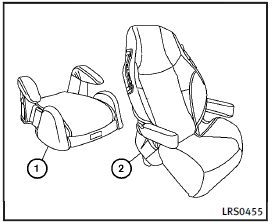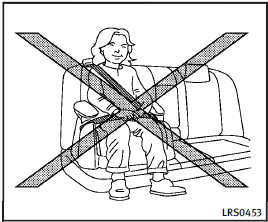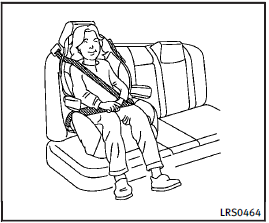Precautions on booster seats

WARNING
If a booster seat and seat belt are not used properly, the risk of a child being injured in a sudden stop or collision greatly increases:
• Make sure the shoulder portion of the belt is away from the child’s face and neck and the lap portion of the belt does not cross the stomach.
• Make sure the shoulder belt is not behind the child or under the child’s arm.
• A booster seat must only be installed in a seating position that has a lap/shoulder belt.

Booster seats of various sizes are offered by several manufacturers. When selecting any booster seat, keep the following points in mind: . Choose only a booster seat with a label certifying that it complies with Federal Motor Vehicle Safety Standard 213 or Canadian Motor Vehicle Safety Standard 213.
• Check the booster seat in your vehicle to be sure it is compatible with the vehicle’s seat and seat belt system.

• Make sure the child’s head will be properly supported by the booster seat or vehicle seat. The seatback must be at or above the center of the child’s ears.
For example, if a low back booster seat 1 is chosen, the vehicle seatback must be at or above the center of the child’s ears. If the seatback is lower than the center of the child’s ears, a high back booster seat 2 should be used.
• If the booster seat is compatible with your vehicle, place your child in the booster seat and check the various adjustments to be sure the booster seat is compatible with your child.
Always follow all recommended procedures.

All U.S. states and Canadian provinces or territories require that infants and small children be restrained in an approved child restraint at all times while the vehicle is being operated.
The instructions in this section apply to booster seat installation in the rear seats or the front passenger seat.
See also:
4WD shift indicator
The 4WD shift indicator is displayed in the
vehicle information display.
The indicator should turn off within 1
second after placing the ignition switch in
the ON position.
While the engin ...
Extending engine run time
time by performing the steps listed in “Remote starting the vehicle” in this section. Run time will be calculated as follows:
● The first 10 minute run time will start when the remote start f ...
Startup display
When the vehicle in placed in the ON or ACC position the screens that display in the vehicle information include:
● Active system status (if so equipped)
● Trip computer
● Tir ...
